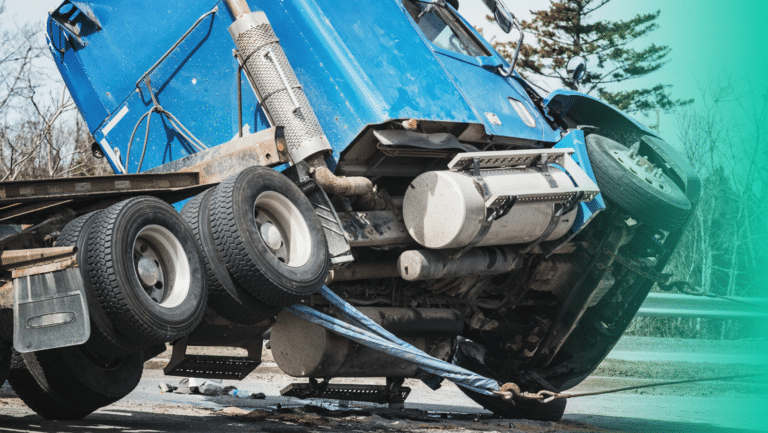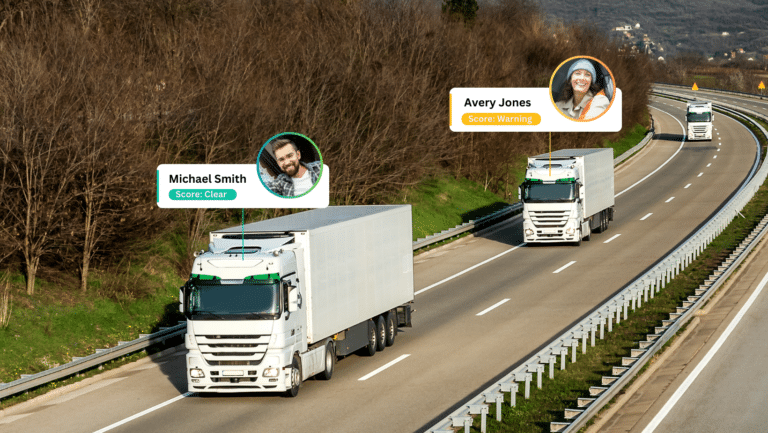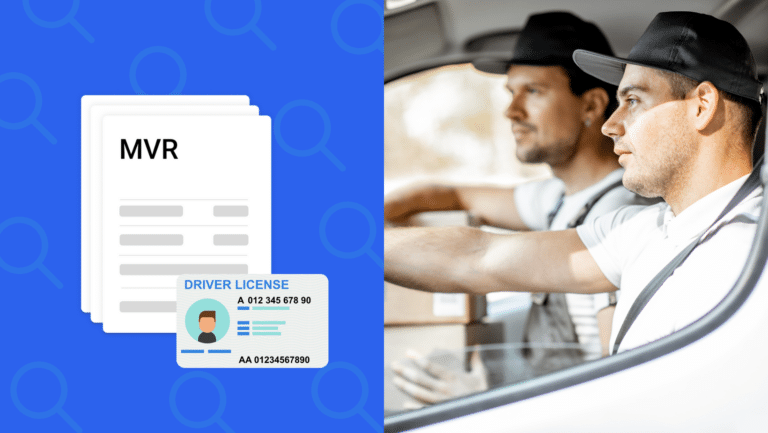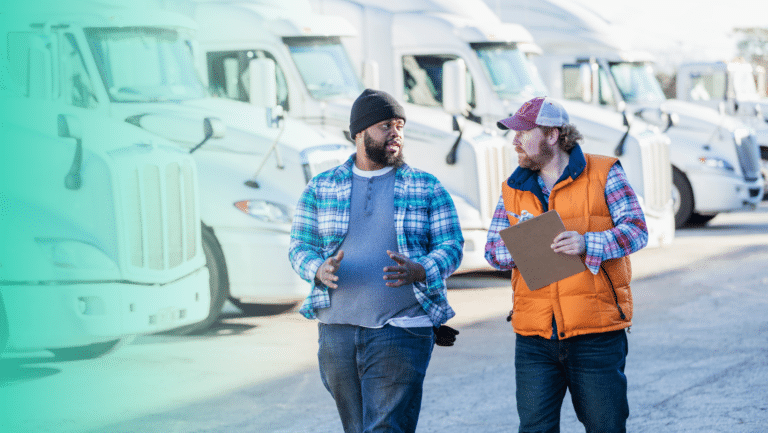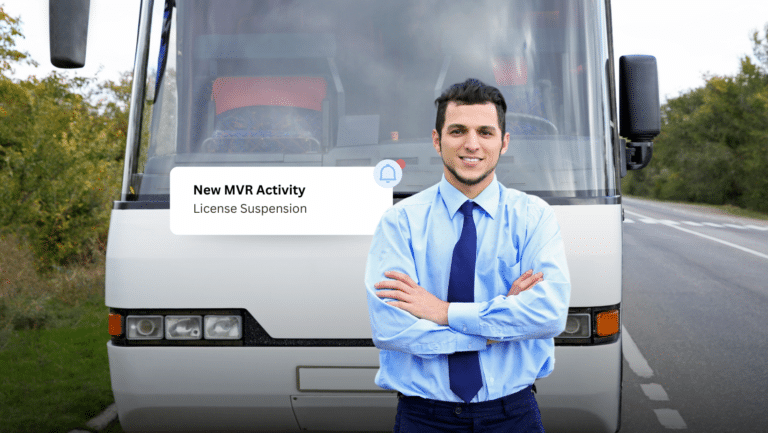Podcast: Identifying & Mitigating Fleet Risks
Fleetio & Embark Safety
In September 2021, we participated in a Fleetio Podcast on the topic of mitigating fleet risk. Check out the audio above or read the transcript below for the full conversation. Contact us with any questions!
Transcript
Podcast — Identifying and Mitigating Fleet Risks
[00:00:00] Zach Searcy: Welcome to the Fleet Code. A podcast brought to you by Fleetio, where we’ll dive into the latest fleet trends, technologies, and best practices. Get the inside scoop. As we decode the challenges of fleet management.
[00:00:20] Kris Gault: Having a risk policy in place, makes you 50% further ahead than the majority of small and large companies. I am so thrilled when someone has some risk plan in place. Just get a plan. You’ve got to start somewhere and then year two, maybe it’s safety, 2.0, maybe it’s safety, 3.0 in the next year, but you have to start somewhere.
[00:00:44] Zach Searcy: In this episode, we welcome Kris Gault from Embark Safety and MVR Monitoring Service. We’ll chat about potential risks that fleets face in the process of rolling out your own risk management and driver safety policy and ways to leverage existing partnerships to create a comprehensive risk management plan. Kris, we’re excited to have you on today. Tell me about yourself and what you do?
[00:01:06] Kris Gault: Sure. Thanks so much Zach, are excited to be here. You know, our favorite subject to talk about is MVRs and DMV’s which most people don’t like to talk about. So it’s exciting to be sitting with you here today. Our team works at a company called Embark Safety, started in 2010 and we monitor the driving records of employees nationwide for companies. It sounds relatively boring, but it’s become such an important part of the risk management for companies nationwide.
[00:01:36] Zach Searcy: Yeah, I love that. So I’d like to start at the top in order to prevent risks. I feel like an important thing is to first identify the risks that might exist, but also identifying risks feels like it’s something that could be a slippery slope. You just keep identifying new and new risks. What are some of the most common ones that you see?
[00:01:53] Kris Gault: So I think our conversation is extremely timely right now. So as people look to mitigate risk and to become a safer company and create safer communities, which has been our absolute mission, some of the things that they’re mostly looking for, and some of this is predictive of the drivers for their companies. Now, these people might not be necessarily driving a company owned vehicle. They could be a great member of our team who runs out to FedEx in their own car. That gets into an accident. Now, the person that they unfortunately hit is not going to see that person they’re going to see the company because it was on the company’s own time. So companies are essentially looking for our behaviors, whether it’s in a speeding ticket or gosh, forbid a suspension, so that they could make right. Corrective action for a couple reasons. Maybe it’s for brand management, maybe it’s because they want to prevent an insurance spike. You know, when people are supposed to know everything that’s going on with their company right now, we do not want to be caught where you should have known and they are monitoring in essence, helps people know in real time so they can make the best corrective action. You know, a terrible statistic is that. Drivers with suspended licenses are three times more likely to kill or seriously injure others in collisions. So how do we prevent that from happening a second or gosh forbid a third time.
[00:03:23] Zach Searcy: Are there any risks that most people might be overlooking? Is there anything that you’ve seen within a fleet that people wouldn’t typically think about.
[00:03:31] Kris Gault: Yeah, I think that’s a great question. What we try to do at Embark is to really educate our customers. So some of the first questions we’re going to ask people when they come to us are, do you have a vehicle driving policy in place? It’s extremely important. Fleet managers know self-reporting does not really work unless you have some sort of monitoring platform in place. But a specific driving policy understanding when, who, can your spouse drive your car? Can your spouse drive your company car in place? Very simplistic things with that. If the company comes to us and they do not have that in place, we can absolutely provide some real life examples from them.
The other thing is risk managers. Human resources and safety consultants often look at outside violations of suspensions as commercial auto insurance. Commercial auto insurance has on average been a loss leader for underwriters since 2012 and has been progressively going up over every year. Even if you do everything correctly. You’re probably going to see an increase on average between 14 to 20%. Even if you do everything correctly. In fact, in about 2019 crashes cost employers over $72 billion, that was up from $47 billion in 2014. So as risk and safety manners consider putting a program in place, not only is it important to you have a policy, a program. But also engage with their insurance partner to ensure that this is something that they are on board with and also supportive. So there are no surprises at the end of the year when it’s time for the renewal to be up.
[00:05:11] Zach Searcy: So if I had to guess most risk management plans are implemented with compliance in mind. They’re trying to meet somebody else’s regulations that are set in place. I feel like the way to get the most out of your risk management plan is to make sure that it’s tailored to you specifically and to your team specifically, and your needs specifically.
[00:05:28] Kris Gault: Having a risk policy in place. It makes you 50% further ahead than the majority of small and large companies. I am so thrilled when someone has some risk profile or risk plan in place. Companies are getting more savvy, especially because risk and safety have been such a hot topic. One of the two major pillars in the past year and over time that will morph. So if someone has something in place, I think that’s great.
What I think you’re alluding to is that culture deck of what’s acceptable for each company and what’s acceptable for not, there’s a lot of companies that do come to us with that. There’s a lot of them, we do discuss how to get to those specifics for your company. But I would say having a plan in place, just get a plan.
You’ve got to start somewhere and then in year two, maybe it’s safety, 2.0, maybe it’s safety 3.0 in the next year, but you have to start somewhere. The barrier to entry for us and monitoring companies is it’s not an all or nothing approach. So when a company comes to us and another monitoring partner, you don’t have to monitor every single one of your drivers.
For a lot of companies, they don’t necessarily think of the great lead, which is those that don’t necessarily drive for a professional living, could be their sales reps, could be their office employees. They don’t necessarily think of putting them at risk, although it creates a lot of liability for them.
So safety 1.0 and years, having a risk management plan and monitoring those critical drivers and maybe pulling the NBR for those other drivers twice a year. Safety 2.0, all right. Let’s get granular with this plan. Let’s make it a culture deck of safety for our specific company and let’s monitor a hundred percent of their drivers. So for us starting somewhere is the number one step that people need to take in this industry.
[00:07:18] Zach Searcy: So if you don’t have a plan, make sure that you create a plan. It can be a standardized plan. It could be a general plan. It can be something that you’ve pulled from other people within the industry. And then it’s not a one and done thing. Revisit your plan annually?
[00:07:31] Kris Gault: At least annually. So when we started in 2010, we really started as a bumper sticker company. You know, one 800 how’s my driving? My CEO veered off the road because a big truck veered him off. And he says, oh my goodness, there’s gotta be a better way. How do I report this traffic? What if my children were in the car? If we would have not reviewed our plan and reviewed how the industry changed, how people changed, how people communicated. We are still pushing bumper stickers. So quarterly, Hey, if you’re reviewing annually, you are better than most, but I would love to see people review it quarterly because things always change
[00:08:07] Zach Searcy: And the technology is changing and the landscape’s changing as a whole.
[00:08:11] Kris Gault: Absolutely.
[00:08:13] Zach Searcy: Yeah, I love that. So you mentioned talking to your insurance provider, trying to build a plan that works with their regulations and their policies in mind. What are some questions you can ask your insurance provider?
[00:08:24] Kris Gault: Sure, and you know what insurance is so incredibly, just like the DMVs and MVRs are complex. Insurance is very complex because you have a carrier, you have a broker, you have your agent, you have your risk consultant. So there’s so many differences between people that are all working on the behalf of their clients and their insured to provide the best program and plan for them. So right now, with commercial auto insurance and he’s nuclear verdicts going absolutely through the roof, commercial auto is not the most fun thing to write.
And I know because I work with a lot of our insurance partners may hear this quite often. A couple of questions. You can ask your insurance partner, whether they’re your carrier or whatnot, what are the necessary steps or how often should I be checking my driving record? What are the corrective actions I should take?
What are the things I should look out for? Most great insurance partners will have suggestions around this. Will you see it as a positive? If I establish MVR or monitoring? Every day someone asks me. Well it saved me on my insurance renewal? And I would be in such trouble if I said yes. So I do not say yes, but I do remind them that it might not see you on the renewal, but it will save you a loss of brand management. Your brain will go through a lot of bad things. If something terrible were to happen and the unfortunate cost of what it’s going to cost to recover an accident or an injury for someone that accrue to your company that should have been prevented. Cause you should have known that they had a suspended license.
So there’s a multitude of questions. But I would say that all of the insurance partners that really care and I’ll say every single one, the opportunity privileged to work with. All strongly care about their insured. So just open the dialogue, you do not know the exact language with which to talk about, but even if you say, look, I’m thinking of establishing an MVR monitoring program, can you help me with the vehicle policy?
[00:10:16] Zach Searcy: Yeah, and I think that’s the most important thing in general is just leverage your resources that you have. You have people around you, and ideally you could surround yourself with people who are knowledgeable, kind of across the spectrum. I appreciate that, and that’s good to hear. So one of the things you’ve talked about is communicating with drivers or trying to get approval from drivers to implement vehicle monitoring systems.
What are some of the ways that a manager can go to their driver and say this? Because I have to assume that drivers are a bit apprehensive to have dash cams in the car or a GPS monitor.
[00:10:46] Kris Gault: Yeah, I would say today, it was much easier than it was in 2010 when we started to get the buy-in from the drivers. But I’ll tell you one of the hardest things, even more than the drivers, is that safety professional, that human resources or that risk consultant rolling this program out to the managers who essentially have to tell their employees. So we’ve created some best practices. We worked with incredible brands across the United States, Amtrak, Bridgestone and all of them have created best practices. How do I roll this out to our managers? You know, a lot of it is from education. You have to educate the people that work for. You have to understand that at the end of the day, safety is our most important factor. Now the employee, If there’s friction, I’m not going to lie. Everyone’s thinking, oh, they’re, you know, big brother is watching me again.
But if you can explain it, you know, right now, most people are very used to things such as telematics and dash cams in their cars, but monitoring the driving records will also prevent the employee from simple things as their license expires. So you’ll be reminded 30, 60, 90 days when your license is about to expire. There’s many best practices to roll it out. And then we have things to make it easier. For the risk consultants, such as e-consent forms, things of that sorts.
[00:12:02] Zach Searcy: Cool. So communicate the safety impact that it’ll have on your drivers, but also communicate the safety impact that it’ll have on the community that there with within.
[00:12:11] Kris Gault: Absolutely the most important thing that we can do is empower the people that we work with, communicate to them why these decisions are coming down.
So the more preemptive communication. So we are rolling out a new safety program. There is no other time better than right now to strengthen all of your safety and risk management standards. It is a heightened pillar for every single large or small company that we work with. So it’s a perfect time to be rethinking. How do we make our company community even safer than it currently is? So really explaining the benefits of how it’s going to help the entire company rather than making it about the company itself is really good, but people love knowledge. They want to be empowered, no one likes to be surprised, so communicate to them. But we have scripts and samples of how other people have rolled it out to their teams as well.
[00:13:05] Zach Searcy: Awesome. So you’ve worked with many different people. You’ve worked with many companies as they’ve implemented new risk management policies and best practices. Is there anybody that you’ve seen who has done it really well?
[00:13:16] Kris Gault: I’ve seen so many different roll-outs and policies. I think of one and what I really appreciated about how they were doing this is how they had everyone involved.
It was not the decision of simply the safety manager. They included their human resource managers. They included another member of their team that was agnostic to make sure that this was going to be easy process for them. So the more that you can include additional forces outside of just that one person, one has better buy-in from the company.
And secondly, it lets them see how it can affect not only their specific industry or their specific position, but how it affects the company as a whole. Now this is a large company, so not every company and small business has the luxury of having a CFO and a safety manager. Sometimes the companies we work with just have one person in place. That’s doing human resources, 5,000 safety tasks and all of the operations. That’s pretty normal for a small business these days. So for them, I’ve seen them roll it out in a really great efficient way because they’ve created a great vehicle policy that was brought in by all of their employees. And they’ve realized this tool is just going to make it easier for them. So they can really focus on the most critical tasks at their job that are not just merely monitoring the driving records for all their employees.
[00:14:37] Zach Searcy: So with the adoption of new technologies, obviously this is a landscape that’s ever changing, and we have autonomous vehicles coming in now where an individual’s driving record isn’t as big of an element as it is currently. I guess that we’ll have to see new risks that are also introduced into this.
Do you see any risks in the future that don’t exist right now?
[00:14:57] Kris Gault: I mean, I think that’s some of the things that keep us up right now, is that how we remain relevant? So I think a couple of things I see coming in the future for us is better predictive analytics. And we’re working on that right now. So we can predict forward moving as opposed to just having to be reactionary. That’s a big thing I see coming in our industry right now is predictive analytics. And we’re working hard to make that a part of what we’re doing. Predictive analytics is a big thing , driver education continues to be a hot topic and the evolution of that to make it more exciting and relevant for people to be part of.
[00:15:31] Zach Searcy: So with predictive analytics, what are some of the individual metrics that you think will start to track moving forward?
[00:15:37] Kris Gault: So that could be the speed of the car that you’re currently driving. Are you considered a safe driver? Are you making rigid turns so that we can be able to prevent, prescribe before an accident is to occur. Our headquarters are in Orlando, Florida. Although we have autonomous vehicles here and we’ve actually piloted the first program for autonomous buses. We still have a driver sitting adjacent in case something were to occur. So we’re not there yet, in which we’re going to be 100% autonomous, but predictive analytics for our current drivers is a giant focus for all of us in this technology safety driving industry. It’s not just for MVR monitoring because the more power, the more information, the more predictability that we can give to our customers and clients, the more that they can prevent any nightmare accident happening. What are the other things I see happening in the future? People want to streamline everything. They want to streamline their safety. They want to streamline their human resources. They want to streamline this process. So consolidation of businesses, people being able to offer more than one suite of service, partnerships, the power of someone that’s great at what they do, working with someone else. Who’s an expert in their industry, things that save them time and create more value for them.
[00:17:00] Zach Searcy: Well, and to your point, there’s often one person managing all of these things, and that can be a bit much, and it’s a lot to expect of somebody. So obviously we want to be able to surround ourselves with team members and software services and professionals who can help us really streamline everything into the tightest space possible, just because we don’t have time to handle everything.
[00:17:21] Kris Gault: Time is the only thing that’s a finite resource. We have no more of it. So people want more information, but right now, data analytics, what’s coming out. What we are developing, what we see occurring in the industry is so powerful, right. Even from the insurance side to the company and consumer side.
People are more empowered than ever to make the best decisions for themselves and for their company. Back in the day, people still do, maybe it’s not back in the day. People would pull an MVR record one time a year, there’d be one person at your company. And they would review that MVR. They were never qualified to review that motor vehicle record. And it would take him maybe three or four minutes. And that would decide if they were safe to drive for your company or not. Now we take the guesswork out of that. The DMVs are so complex. One of the things that keeps us the most busy is the changes in compliance. It’s a very complex industry. So now we take out the guesswork for our clients to automatically decipher, who’s a good driver and who’s a Bad one?
[00:18:25] Zach Searcy: Yeah. And if you’re only checking once a year, a lot can happen with an individual driver over the course of a year.
[00:18:29] Kris Gault: If you’re only checking one time a year, there’s so many gaps. So what happens if you check someone’s record in January and they get into a DUI or they don’t pay their child support, which is a reason for a license suspension in March, it means that you have no opportunity to make that good for yourself or your insurance partner until your renewal is up. And gosh, forbid something happens in between there. We cannot afford to risk waiting months and not knowing you should have known as unfortunately, the sentence that I hear all the time. You should have. No, you should have no. Well now they can know.
[00:19:04] Zach Searcy: So we’ve got driver records. What are some other opportunities for bringing in data and really trying to get a full picture of somebody’s fleet and the possibility for risks?
[00:19:13] Kris Gault: So another portion of our business I’ll be at a small portion because the trucking industry in the United States is a small business, but it’s the most hardest hit by commercial auto hikes every single year, plus how difficult it is to find great drivers for their companies. So DOT compliances are a critical portion of what they do. We often see a combination of dash cams and telematics and MVR monitoring because MVR is a critical piece of their DOT compliance. So marrying those three things together for a company is incredibly powerful to keep their license strong and to keep their drivers health at a high level. And they will definitely know when things arise.
[00:19:54] Zach Searcy: Well, Kris, thanks for joining us again. I want to make sure that we cover anything that you had in mind. Is there anything else that you’d like to tell people who have questions about risk management or risk?
[00:20:03] Kris Gault: I think we’re in a time right now where risk management and safety is such a hot topic. It’s the perfect time to be rethinking everything, to be making complex things simple, to be utilizing innovation, to your benefit, to be working with partners who are just as progressive as you are. As much as technology is important, service and customer service is still one of the highest sought. So work with partners that share those same values. I mean, people mostly come to us because they want help with their insurance renewals. They’re working on their brand reputation. And at the end of the day, how do we create a safer company?
[00:20:42] Zach Searcy: I appreciate that, and I really appreciate you joining us today. I think that there are so many people, as you said, who are looking to enter risk management for the first time. And I think it can feel like this daunting task, but if they leveraged partners or if they start with a general risk management plan and then try to grow on it from there, I think there’s just an opportunity to really make their team and their community safer. So I appreciate you joining us to talk.
[00:21:04] Kris Gault: Yeah, thank you so much. People expect to come to us and they think that they need to know everything. If people come to us and they have no idea what we do, it’s really only become fashionable in the past year and a half or two years, although we’ve been around for over a decade.
So find a partner that you can ask questions to that’s going to hold your hand in education. That’s going to help you with implementation and rollout for your company. And it will make it so much easier for yourself. This is an incredibly complex industry, but it should not be complex for you if you find the right partner in risk management and safety to help your company prosper and grow.
[00:21:39] Zach Searcy: Absolutely. So I’ll include your company information in the podcast description below. So if people are looking to learn more about you and Embark Safety they can go there. But thank you so much again for joining us.
[00:21:50] Kris Gault: Oh, thank you, Zach. This was really fun. Good luck.
[00:21:55] Zach Searcy: Thanks for listening to another episode of the fleet code.

